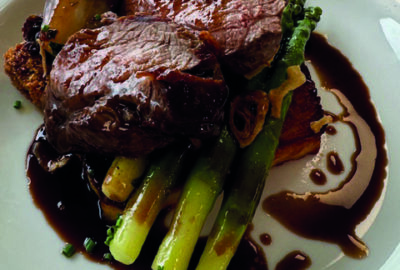AHDB chef and master butcher Dick van Leeuwen helps independent caterers to venture into the cured meat market with a simple dry cure method.
Curing is an ancient method of preserving food, which has created a valuable market in the UK, generating more than £2.3billion of retail sales this year alone from sliced ham, gammon and bacon. It is possible to cure a wide variety of meats and fish. Most commonly, loin of pork is used for back bacon, belly pork is used for streaky bacon, and brisket or silverside creates pastrami or salt beef.
There are three primary methods:
• Dry curing, simple but effective, where salt is rubbed onto the meat
• Brine curing, using salt and water – the meat is soaked to allow the brine to penetrate. The process is more laborious because salt levels need to be controlled and it can be dangerous if mistakes are made
• Injection curing, where brine is injected into the meat. This is most suitable for larger cuts
To tap into the market, there are simple but important dry curing steps to follow:
Preparation Before starting the curing process, clear the work area and wear disposable gloves to reduce cross contamination when applying the mix.
Applying the mix Weigh the meat and apply the dry cure mix in the recommended ratio. If using a traditional dry cure mix, use 3% (30g per kilo of meat) or follow manufacturers’ instructions.
• If the rind has been removed, cure penetrates faster through muscle, so add 75% of cure to the muscle and 25% to the back fat
• If curing rind on, cure penetrates rind very slowly, so apply only 10% to the rind and 90% to the muscle.
Timing and turning
• Dry curing takes one day per centimetre of meat thickness, plus two days.
• Label the pack with packing date and the date the meat needs to come out.
• Rub the curing mixture in well and pay particular attention to pockets and cavities.
• Vacuum packing the treated meat will slightly hasten the curing process, but more importantly, it will protect other meats in storage.
• Store the meat at 2-4°C, turning every two days to ensure even curing, avoid pressure marks and check the condition of the seals. A lower temperature will slow the curing process.
Finishing off Ensure all utensils and work surfaces are thoroughly washed to remove traces of curing salt. After the process is complete, lightly rinse the cured meat to remove excess surface salt and do not soak. Air-dry the cured bacon in the fridge prior to slicing and packing, but take care to store it away from other meats.
Trouble shooting for dry curing
1. Lack of flavour Incomplete cure due to poor distribution of cure or insufficient cure used
2. Colour problems a. External colour fades but the pork remains pink inside. This suggests cured pigment has been oxidised by strong light in storage – common problem when neon lights are used b. Green or grey patches may indicate an incomplete cure due to too short a curing time, or storage temperature being set too low c. Green patches may indicate nitrate burn due to poor distribution of cure, bacterial spoilage due to failed vacuum seal, or the storage temperature being set too high
3. Sour odour or flavours This can be caused by rancidity following oxidation of fat, the storage life may have been extended too long, or as a result of long exposure to strong light in storage
4. Musty/cheesy odour Bacterial growth due to insufficient curing salt used, or poor house keeping resulting in spoilage, or excessive storage temperature.



